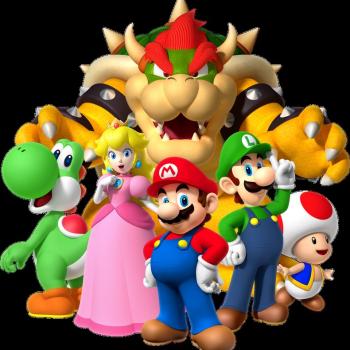Review of Beauty and the Beast, Directed by Gary Trousdale and Kirk Wise
When you think Disney, you think of bright colors, a mouse, princesses, enchanted castles, music and song, and possibly overpriced theme parks. But perhaps above all, you think of childhood. Disney specializes in a certain kind of entertainment (or marketing). It speaks to children, including the inner sort—those who are still under the age of 12 and those of us who remember being so once upon a time. Disney is all about nostalgia.
My kids are just now old enough to sit through a family movie night, which suddenly makes it urgent for me to find family-friendly movies. In a sign of how successful Disney has been at cornering this particular market, my first thought was to put the Disney canon in my Netflix queue. Somewhere, a Disney marketing executive is patting himself on the back.
The thing is, sometimes Disney makes a real gem. For every cynical, manipulative, market-driven cut-and-paste effort like Hercules (1997), there is an Aladdin (1992) or Lion King (1994).
Above all, there is Beauty and the Beast (1991), the first animated movie ever to be nominated for Best Picture—back when they only nominated five movies per year and the honor actually meant something. It won the Golden Globe for Best Musical/Comedy, was turned into a Broadway musical, has been preserved on the National Film Registry, and is IMDB’s 230th greatest movie of all time. It is easily the best hand-drawn animated movie ever made and, considering they don’t make them any more, probably the best that ever will be made.
I.
Beauty and the Beast, based on an 18th century fairy tale, is about a (beautiful) French peasant girl who yearns for adventure but becomes imprisoned in an enchanted castle (of course) whose master is a hideous beast. The beast is really a handsome prince under a spell for having mistreated an enchantress disguised as an ugly old woman. Because he judged others on their looks, he himself is condemned to beastly ugliness unless he can learn to love and be loved. Along comes Belle, who obligingly falls in love with him. And they lived happily ever after.
So, it’d be easy to criticize the storyline for basically romanticizing Stockholm Syndrome. Perhaps the original fairy tale gave a bit more depth to the love story, but in the cartoon there is little reason for Belle to actually fall in love with the Beast other than his few mild efforts not to dismember her. He did, after all, kidnap her father and imprison him for life for a mild act of trespassing. To force her into spending time with him, he starves her into submission. They fall in love after he rescues her from a pack of ravenous wolves.
On the other hand, it is equally easy to praise the movie for reflecting a nice little moral about how true beauty is within. Remember God’s words to Samuel when anointing David (“Do not consider his appearance or his height, for I have rejected him. The Lord does not look at the things people look at. People look at the outward appearance, but the Lord looks at the heart,” 1 Samuel 16:7). The very concept of “inward beauty” probably comes from 1 Peter 3:3-5, which explicitly contrasts the beauty of “outward adornment” with that of the “inner self.”
But just for fun, let’s pick on a few other, subtler themes instead.
II.
Note how the movie plays with gender. Belle is a well-developed, interesting character. She is an oddball and a bookworm who yearns for an interesting life. “I want much more than this provincial life,” she sings, “I want adventure in the great wide somewhere, I want it more than I can tell.” Part of her charm is that she is feisty, ambitious, energetic—and a little combative. She has “so much more than they’ve got planned,” with “they” being, presumably, the townsfolk. Belle isn’t a woman who is going to let the world tell her what to do or who to be. This is a story of female empowerment (except for the part where she falls in love with her jailer).
By contrast, the male characters in the story are thin caricatures. (Which, come to think of it, is true of pretty much all Disney movies, isn’t it? When was the last time a Disney prince was anything other than Charming or Arrogant, or both?) Gaston, the burly man’s man out to marry Belle, is praised in song for being manly, with reference to fighting, wrestling, biceps, spitting, being physically large (as a barge!), shooting, wearing boots, and hunting. These make him a “man among men,” as they sing. Gaston is pompous and vain, held up for mockery and contempt—him and all his manly attributes with him.
The Beast is another caricature of overwrought masculinity: all aggression, anger, muscle, and shouting. Belle comes to love him as he submits to her civilizing influence: he becomes good insofar as he becomes tame.
Now I’m not going to complain that Gaston and the Beast are actually just fine the way they are and that Disney is being disrespectful towards masculinity by mocking and taming them, respectively. Men who are as arrogant and vain as Gaston or brutal and angry as the Beast—and I’ve known a few—aren’t good models of masculinity by any stretch. Maybe Disney is hitting a few inoffensive targets along the way—what’s wrong with wearing boots?—by way of collateral damage.
No, my complaint is that Disney could have put just a tiny bit more effort into developing believable, non-caricatured male characters. Boys need fairy tales too. I suppose they have them in the likes of Star Wars—which is now a Disney property, so I guess it evens out.
III.
But my bigger complaint about Beauty and the Beast—and many, many other movies—is the Salvation-By-Romance trope. Beast is redeemed by learning to love—specifically, by falling into romantic love with a pretty girl. It seems to me that lots of movies use the idea that men become better human beings by falling in love; that falling in love makes their past faults forgivable; that catching a girl is enough to change his nature from brute to gentleman. All you need is love.
Beauty and the Beast explicitly relies on this trope more than most movies. We are told at the beginning that when Beast was cursed, he was given the ability to break the curse “if he could learn to love another, and earn her love in return.” Love, in this view, is something to be merited by effort and hard work—specifically, work at moral improvement. If I work hard enough, I deserve to be loved by you. That’s why the act of loving is conflated with moral goodness: the things you do to earn another’s love are acts of general moral worth.
My problem with this is twofold. First, real love is neither earned nor given like an entitlement: it should be given like a gift. Belle’s love for Beast is more like pride in a well-trained puppy, while real love should be mutually respectful care between equals.
Second, insofar as love is crucial to moral growth, it is agape, not eros. The world has elevated romantic love to be a cardinal virtue, such that we are cleansed and elevated by finding someone to fall in love with. This borrows heavily from Biblical rhetoric, but not Biblical theology. It is true that “God is love,” (1 John 4:8), that love is the greatest of theological virtues (1 Corinthians 13:13), and that Christians should be noticeably different from the world precisely because we love one another (John 13:35). But none of these verses are talking about romance. They are talking about agape, self-sacrificial concern for another’s good. If you’re unfamiliar with the different kinds of love, go read The Four Loves by C.S. Lewis.
To state the obvious, romance is not a virtue. It is a pleasant by-product of friendship between men and women—one on display throughout the Song of Solomon. But it is 19th century idolatry, not Biblical wisdom, to hold up romantic love as a virtuous ideal that makes us better human beings. “Falling in love” is neither difficult nor rare, and therefore not particularly praiseworthy. The worst criminals in the world will enjoy romance given the right circumstances.
IV.
It is true that women civilize men. It is no threat to masculinity to recognize the obvious truth—as old as civilization itself—that much of what men do, they do to win the praise of pretty girls. That’s an old-fashioned way of looking at gender—and I mean that as a compliment. Beauty and the Beast gets at least that much right. But insofar as the story implies that our ability to woo a woman makes us better people, or that we merit love by our efforts, or that romance is an ennobling virtue, Beauty and the Beast is a fine hymn to the church of Disney and the cult of romance. I’m not trying to be a stooge about a delightful film. Don’t get me wrong: I thoroughly enjoy the movie and am happy to let my kids watch it (although we’ll have a talk when they’re older). But if you think I’m over-analyzing things, don’t get me started on The Little Mermaid.












